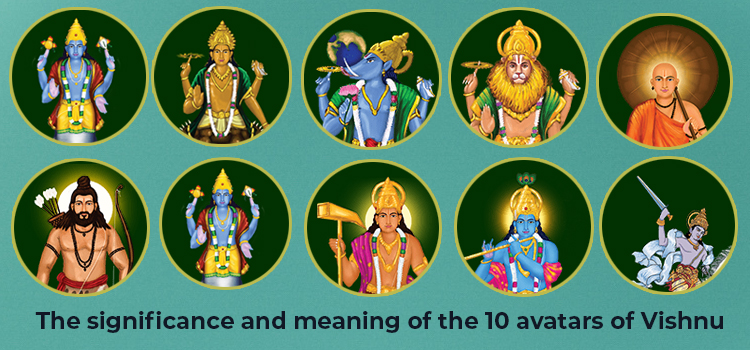The significance and meaning of the 10 avatars of Vishnu

The endless cycle of births and deaths is represented by the Yugas in Hindu mythology. In each of these Yugas, Lord Vishnu takes an incarnation in order to restore the rule of Dharma or righteousness on Earth. Altogether, there are 10 avatars of Vishnu, and they are called Dashavataram.
Vishnu is revered as the deity who preserves the Universe. He is said to have incarnated in different forms in the Satya Yuga, Treta Yuga, and Dwapara Yuga. He is yet to take his tenth avatar and is expected to incarnate as Kalki in the ongoing Kali Yuga and restore Dharma when Adharma crosses all boundaries of the imagination. Each avatar of Vishnu serves a purpose. The chronology of his avatars also hints at how evolution took place.
Let us know more about each of the avatars and understand their significance:
Matsya
In this avatar, Lord Vishnu took the form of a fish to save Manu (the first man) from Pralaya (great flood). Interestingly, the fish was one of the primordial forms of life. The process of evolution began underwater, and therein lies the significance of the Matsya Avatar.
Koorma
Vishnu took the form of a Koorma or tortoise and bore the weight of the Mandara mountain when the Gods or Devas and the demons or Asuras were churning the Milky Ocean for Amrita (divine nectar of immortality). In evolutionary terms, a tortoise is an amphibian that is able to survive both in water and on land.
Varaha
As Varaha or the wild boar, Vishnu fought a raging battle with Hiranyaksha to save the Earth. Hiranyaksha had submerged the Earth in the ocean away from the Universe. Vishnu scooped out the Earth from the ocean with his tusks and thus rescued it from getting drowned. Varaha or a boar lives on the surface of the Earth and indicates a stage in the evolution graph.
Narasimha
In this avatar, Vishnu appeared as half-man and half-lion to save Prahlad from his evil father, Hiranyakashipu, and destroyed the evil forces on Earth. By appearing as Narasimha, Vishnu showed how different kinds of life evolved on Earth.
Vamana
Vishnu appeared as the dwarf, Vamana, to rescue the three worlds - Prithvi, Deva, and Patala from the clutches of the demon king, Bali. Vamana appeared before Bali during a Yagna and asked the king to give enough land that he could cover with his feet. As soon as Bali agreed, Vamana became gigantic in size. After covering the sky and earth with 2 steps, there was no more space. So Bali offered his head. Vamana placed his foot on Bali’s head and pushed him into Patal. This avatar describes the evolution of human beings.
Parashurama
Vishnu took the form of Parashuram to make people understand the duties of a Brahmin and a Kshatriya. He was an ardent devotee of Shiva and was given an ax as a boon. Parashurama's weapon or ax indicates a stage in the evolution of the human race. The earliest humans lived in the jungles, and an ax was one of the earliest weapons they created for survival purposes.
Rama
Vishnu took birth as Maryada Purushottam, Rama, in the Treta Yuga to kill the demon king, Ravana. The avatar also revealed the various duties of a person and the importance of Dharma or righteousness in society. Thus, from the evolutionary perspective, man moved away from the woods to create a civilized society.
Balarama
Balarama, who is also an avatar of Sesh Nag, is believed to be the eighth incarnation of Vishnu. ‘Bala’ means strength, and he is associated with the plough which is used by farmers. From the evolutionary perspective, Balarama’s avatar highlights the importance of agriculture.
Krishna
Vishnu was born as Krishna not only to kill his evil uncle, Kamsa but also to enable humans to evolve as a society. By revealing his Vishwaroopam to Arjuna on the Kurukshetra battlefield and giving him the Geetopadesam, Krishna discussed the fundamental realities of the journey of life. The avatar highlights the evolution of human intelligence.
Kalki
Kalki is Vishnu's tenth and last avatar. He is yet to appear and is expected to arrive during a period when the world will witness the darkest side of humanity. Kalki will come forth to destroy Adharma and create a new civilization that will mark the beginning of a new Yuga.
Dashavatar Homam is usually performed to invoke the powers of the ten avatars of Vishnu. Dashavatar Homam is believed to remove planetary doshas, protect one from enemies and provide Moksha or salvation.

Why Do Candidates Fail In The Oracle 1Z0-998-20 Certification Exam?
- The innovation business is apparently the quickest developing vocation decision in most creating countries.Even if you only been involved with homeschooling on.

Most people with psychosis take powerful drugs to keep delusions and hallucinations
- Jezero is thought to have held a giant lake billions of years ago And where theres been water theres the possibility there might also have been life of Mars

Matte Coated Paper Market 2021 | Industry Demand, Fastest Growth, Opportunities Analysis and Forecast To 2027
- The Matte Coated Paper Market research report compiled by expert analysts studies the current and the future market trends. Market share, regional study and detailed market dynamics makes it a very co

Download Microsoft AZ-304 Dumps To Clear Azure Solutions Architect Expert Exam Smartly
- Best Solutions for your career oriented certification. PDf Questions, Practice test software. Get latest and Actual Exam Dumps For Best Results In Final Exam.